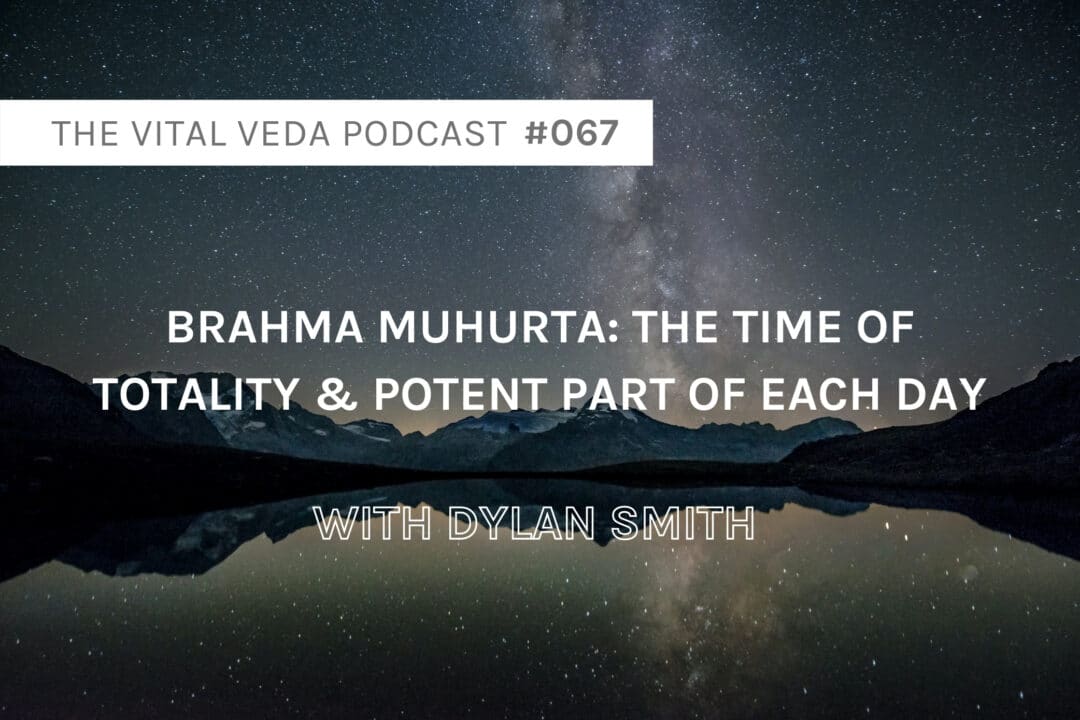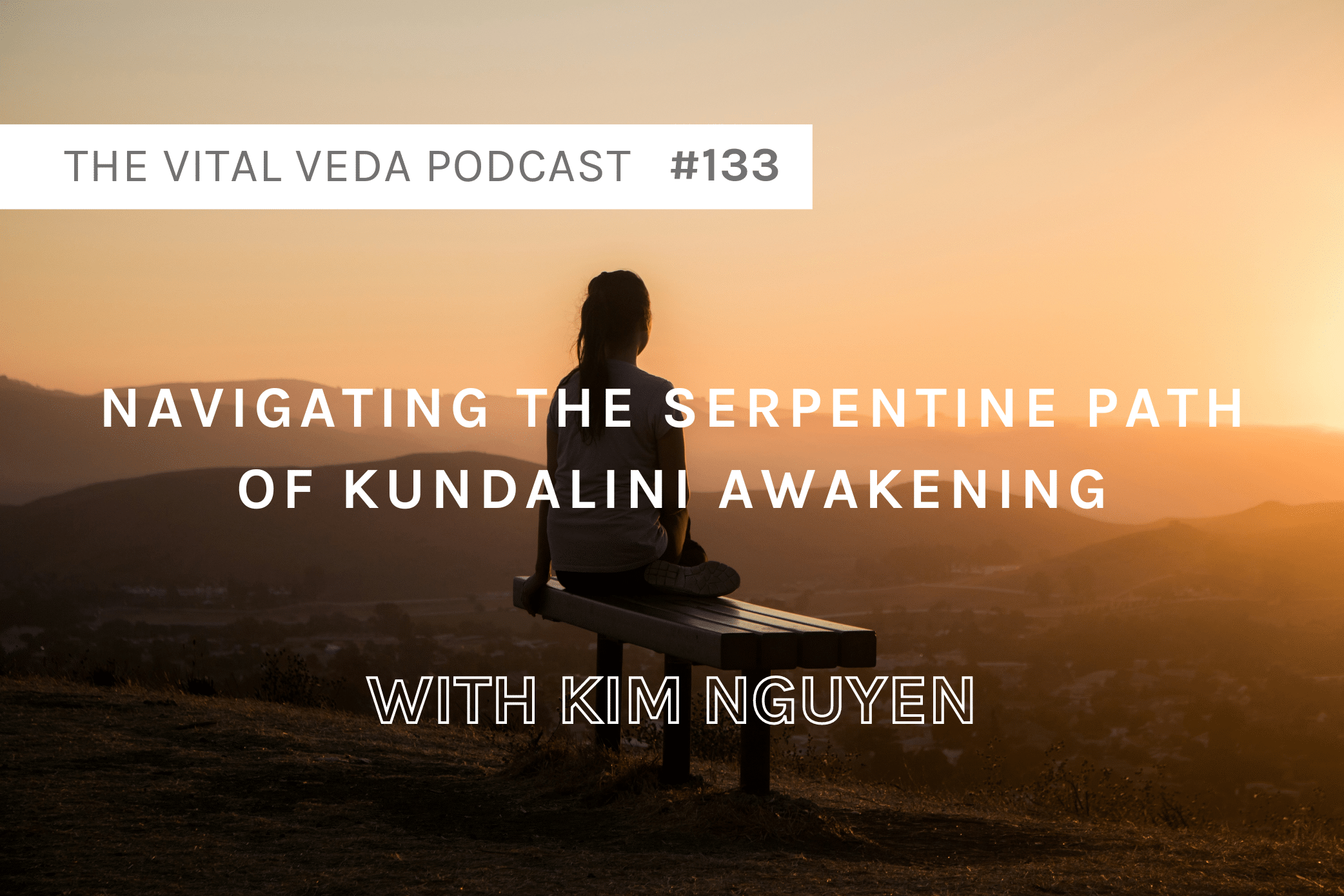The Brāhma Muhūrta, also known as the “time of totality” is the period of the day where creative intelligence is at its peak.
Being able to understand and harness these energies is a fundamental aspect of the Ayurvedic daily routine (dinacharya).
IN THIS EPISODE WE DISCUSS:
An Introduction to The Brahmā Mūhurta
Brāhma in Sanskrit means totality.
-
It is the field of creative consciousness from which everything springs.
Muhūrtha is a unit of time. Vedic tradition divides the day into 30 muhūthas of 48 minutes each.
The brāhma muhūrta is the time of totality.
These are the names of the 30 muhurtas:
- Samudra-muhurta
- Brāhma-muhūrta
- Dyumadgadyuti-muhūrta
- Viṣṇu-muhūrta
- Jīva-muhūrta (also known as Amṛta-muhūrta)
- Aditi-muhūrta
- Kaṇḍa-muhūrta
- Agni-muhūrta
- Vidhātṛ-muhūrta
- Yama-muhūrta
- Aśvinī-muhūrta
- Puṣya-muhūrta
- Ahirbudhnya-muhūrta
- Ajapāda-muhūrta
- Girīśa-muhūrta
16. Bhaga-muhūrta,
17. Aryaman-muhūrta,
18. Varuṇa-muhūrta,
19. Vāhinī-muhūrta,
20. Naktanakarā-muhūrta,
21. Puruhūta-muhūrta,
22. Sutamukhī-muhūrta,
23. Viśvedevā-muhūrta,
24. Vidhi-muhūrta,
25. Varaha-muhurta,
26. Vasu-muhūrta,
27. Pitṝ-muhūrta,
28. Mitra-muhūrta,
29. Āhi-muhūrta,
30. Rudra-muhūrta
The shloka (Vedic hymn) that introduces the aspect of Dinacharya in Ayurveda states the following:
Brahmī Muhūrta Uttiṣtha Jīrṇajīrṇa Niru Payan
ब्राह्मी मुहूर्त उत्तिष्ठ,जीर्णाजीर्ण निरु पहन
Brahmī comes from the Sanskrit word brahmīk – which is the verb form of brahmā.
-
Therefore meaning “that which has Brahma”. When placed before to the word mūhurta, it is saying “The time period that has the value of Brahma, or of creation”.
Utishta means “get up” + Jīrṇa and Ajīrṇa mean “digestion and indigestion” + Nirupayan means “to judge”.
What this shloka is saying is: wake up in the brāhma muhūrta (the time of totality) & judge your state of digestion or indigestion.
The Benefits of The Brahmā Muhūrta
The brahma muhurta is the time period before sunrise.
-
Generally speaking, it is said to go from 3:30 am – 5:30 am, but the cusp of the energies available during this period lies on the last 48 minutes before sunrise.
One should ideally wake up every day during the brahma muhurta.
The brahma muhurta is also considered in Ayurveda to be the part of the day with Vata dominance.
-
Ayurveda divides the day into three parts pertaining to the three doshas.
-
Vata (space & air elements) – from 3am to 6am.
-
Kapha (earth & water elements) – from 6am to 10pm.
-
Pitta (fire & water elements) – from 10pm to 3am.
-
-
The Vata part of the day is where the air & space element become the most dominant; where subtle movement and actions start to occur.
-
The stars are still shining and very much visible.
-
It is the time period where dreams often occur.
-
It is the time when movement starts to happen; some animals begin to wake up & activity is about to start back again.
-
Curiously, it is also the time when people usually wake up to go to the toilet.
-

According to Ayurveda, the most important aspect when it comes to sleep is when one sleeps, rather than how many hours one sleeps for.
-
One should be asleep between 10pm & 3/4am.
-
The pitta (fire + water) part of the day is where the various metabolic processes occur within the body (like digestion of food). Still being active and doing things (even if it is watching a movie or series on your phone in bed) during that time period takes away from our capacity to properly metabolise, which can, in turn, perpetuate various types of ailments in the body.
- To learn more about the optimal guide to sleep listen to Optimal Sleep: The Ultimate Guide | Dylan Smith #045
-
The vata time of the day is also characterized by the quality of gandhana which means “knowledge perception” & sometimes “manifestation”.

-
During the Vata part one is able to perceive and absorb more knowledge and wisdom.
-
According to Ayurveda, this is a great time to study & to do those activities from which we want to make the most out of.
Another quality of this Vata time is gati which means “motion” or “movement”.
-
Waking up during this time period allows one to feel more energized for the rest of the day, you carry on that gati aspect with you for the rest of the day.
-
You feel more energised, creative & light-minded.
-
On the contrary, if you sleep in and wake up during the Kapha period, that earth & sluggish element will be carried forth the rest of the day.
-
-
Another aspect of this gati quality is bowel motion, the elimination of waste (a.k.a. mala kriya), which should be carried out early in the morning – before any coffee or breakfast is ingested.
Waking up during the brahma muhurta will promote the creation of sama dhatu (healthy tissues).
Advice: if you wake up at any time after 3am, to go to the bathroom or whatever reason, start your day right then and there.
-
Brush your teeth, scrape your tongue & do your dinacharya.
Special circumstances:
Cases like infants. the elderly, sick people & night workers are exceptions to these guidelines.
If you had a celebration/event, went to sleep later than usual and in the morning feel the need for some extra hours of sleep:
-
Still wake up during the brahma muhurta, do your dinacharya and once you are done with that, judge what your needs are. If needed, then go back to sleep.
-
BUT, when going back to sleep, sleep for half of the time that you lost.
-
i.e. if you went to sleep 3hs past your bedtime, you can ponder sleeping up to 1.5hs extra in the morning.
-
-
“Waking up and not feeling the need to snooze and stay in bed is an indicator of proper health.”
In Ayurveda there is a concept called sama dosha which consists of our capacity to both rapidly fall asleep at night & waking up energized and full of vitality.
The concept of perfect health in Ayurveda is explained in one shloka of the Sushruta Samhita:
“Sama dosha sama agnischa sama dhatu mala kriyaaha
Prasanna atma indriya manaha swastha iti abhidheeyate”
This means: one is in perfect health when the three doshas (Vata, Pitta and Kapha), the digestive fire (digestion, assimilation and metabolism) all the body tissues & components (dhatus), all the excretory functions (the physiological functions of urination and defecation) are in perfect order with a pleasantly disposed and contented mind, senses and spirit.
SUPPORT THE SHOW
Please leave me a comment below (I love to read every single one).







